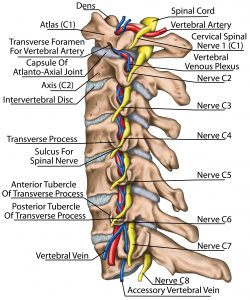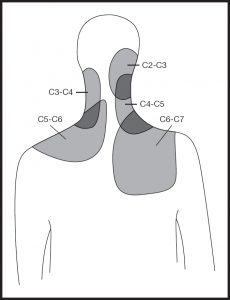Joint Pain in the Neck
Posted by Phil Heler on January 5, 2016The correct term for the neck is the cervical spine. When there is a loss of mobility in the spine, the facet joints bear a greater load than normal.
Facet joint pain in the neck
Typical symptoms: Local intense sharp neck pain with muscle guarding that can refer into the neck and/or shoulder anatomy. The pain usually appears with specific movements (such as looking over your shoulder).
In the spine, facet joints link the vertebrae and are important for preventing excessive rotational and twisting forces which would damage the discs. They also share some of the load-bearing of the spine.
The correct term for the neck is the cervical spine. The cervical spine has seven vertebrae from the first cervical vertebra (or C1) at the top that articulates with the base of the skull through to the seventh (C7) that articulates with the thoracic spine.
When there is a loss of mobility in the spine, the facet joints bear a greater load than normal. This is particularly the case if there is some imbalance in the body and one side of the spine takes more strain than the other.
This can occur for all sorts of reasons such as repetitive strain injury resulting from the workplace (working on PCs for long periods of time) or sleeping in an awkward position or sudden unexpected movements forcing the neck into sudden rapid flexion of extension (as in a road traffic accident).
Once the facet joints are irritated and inflamed people usually experience intense sharp pain for particular neck movements such as rotation and tilting your head back. Pain can be unilateral or bilateral and can sometimes refer into the neck or shoulder. Each joint at different vertebral levels of the neck (cervical spine) will refer to different regions.
Facet joints are also subject to wear and tear and this gives rise to another set of conditions. Just like the vertebra the body reacts to the increased load on the facet joints by laying down more bone in the joint margins (this is called facet joint arthropathy).
This process is accentuated by degeneration of the intervertebral disc which shrink as we age, thus imposing greater load on the spinal joints. In some cases, the extra bone can narrow the gap where the nerves exit the spine and if the bone pinches against the bone (referred to as lateral stenosis), it can cause referred pain into the shoulder or arm.
Rib joint pain
Typical symptoms: Pain between the shoulder blades that is a burning, sharp or stabbing and can refer to the front of your chest. Taking a deep breath or coughing/sneezing can make your rib pain worse.
Your rib cage is made up of twelve pairs of ribs. All twelve ribs attach to the middle of your back (or thoracic spine), but only the top seven ribs form your rib cage and attach to the breastbone on the front of your chest.
The ribs essentially act as a mean of protecting and guarding all your vital internal organs. Their other function is to lift and drop as part of inhalation and exhalation, which is why rib pain often results in pain when breathing deeply or coughing or sneezing. The lower ribs can be a cause of mid and lower back pain and similarly the upper ribs can refer pain in the upper thoracic regions.
For each rib there are two joints that attach to any specific vertebra in the thoracic spine. These joints are called the costotransverse or costovertebral joints. The ribs are also anchored by the bodies of the vertebra to which they attach and the intervertebral discs.
These joints can be a common cause of pain. Common causes are a singular traumatic event like a sudden impact in contact sports or as part of a symptom pattern resulting from repetitive strain injury.
It is also worth mentioning that very occasionally we can have an extra rib at the top of the spine (called a cervical rib) that can irritate delicate nerves and vascular structures in the surrounding tissue.



